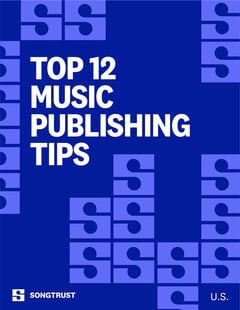Most people aren’t aware of it, but music publishing touches nearly every aspect of our lives. From the first song you remember hearing on your parents’ scratchy turntable to the ones you hear piped over PAs at supermarkets and cafés, there seems to be a soundtrack for every waking moment. And any time we hear music that’s been recorded and widely distributed, each and every one of those songs pass through the vast system we call music publishing.
So, how did we get here? Music publishing as we know it — the blanket term for the creation, production, and distribution of musical compositions — is a few hundred years old, although it didn’t take its current shape until much more recently.
What’s more, it’s nowhere near done evolving. As new technologies and distribution services continue to redraw the map and publishing law changes — sometimes more slowly than we’d like — the publishing landscape continues to evolve to keep up with the pace of independent songwriters in the industry.
Some of the most recent (and impactful) changes came about in 2018 with the passage of the Music Modernization Act (MMA), which points to an even brighter future for music creators. But to understand where music publishing might be heading, it’s important to understand where it came from first.
The Beginnings of Music Publishing
The origin of printed, reproducible sheet music dates back to 1476 and Roman printer Ulrich Han’s Missale Romanum, a volume containing 16 plainchant, or simple monophonic liturgical works. But the father of modern music printing is generally considered to be Ottaviano Petrucci, a Venetian printer and publisher active in the early 16th century. Even from the very beginning, publishing was significantly driven in part by the profit motive: Petrucci held a 20-year monopoly on music printing in Venice.
After the invention of the mechanical method of reproducing sheet music, the next significant development in publishing was the creation of copyright law. With origins in England under the rule of King Henry VIII — who granted printers legal protections in the form of licenses — the language around copyright was further codified under the Statute of Anne in 1710.
Across the English Channel, the French paved the way for our current understanding of performing rights. The Société des Auteurs et Compositeurs Dramatiques (SACD), founded in 1777, is still hard at work today collecting performance royalties for authors of theatrical and audiovisual works. And the Société des auteurs, compositeurs et éditeurs de musique (SACEM) was the first performance pay source (or collection society) when it was founded in 1851. SACEM was founded after a group of composers successfully sued for payment for public performance of their works at a café (a scenario still relevant to songwriters today).
We might call this the beginning of the “era of music publishing,” though it’s useful to note that, in the 1850s, there still wasn’t a way to play back prerecorded music. Instead, it was the intellectual property of the composition that formed the backbone of music publishing law as we understand it.
As musical performances of existing works began to take on greater importance in the music halls, dance clubs and theaters of Europe and the United States, the demand for sheet music of popular works only grew. By the first 10 years of the 20th century, roughly 25,000 popular songs were being written and published every year.
But by and large, the growing music publishing industry wasn’t set up to favor composers. In response, organizations like the Music Publishers Association (MPA) in the UK and, later, the National Music Publishers Association (NMPA) in the U.S. were born. Here, the landmark Copyright Act of 1909 helped enshrine basic legal protections for composers, but the law was often conveniently overlooked or completely ignored by unscrupulous publishers.
For much of the 20th century, in fact, the situation for music creators was bleak. Though the law granted them writing and publishing rights for their original works, all too often the only way for them to earn money was to sell their ownership of these rights away for a lump sum.
By the 1970’s, 50/50 co-publishing deals were more or less the standard, though they still gave publishers an edge in that they assumed some ownership of the writer's share. Over time, this shifted to favor the songwriter, giving them 100% of the writer’s share plus half of the publisher’s share. This is the genesis of the 75/25 split many traditional publishers still use today.
That said, finding a “traditional” publishing deal is far from a composer’s only option. And while scoring a publishing deal was once judged the greatest prize in a songwriter’s career, it’s not the only option available anymore. Here’s why.
Where Publishing Is Headed
The traditional publishing deal isn’t disappearing anytime soon, but several changes in the industry have altered the landscape dramatically, offering up-and-coming composers, songwriters, producers, and creators far more options when it comes to publishing, propagating, and — most importantly — collecting earned royalties from their music.
As we mentioned earlier, the passage of the MMA represented a huge leap forward, as did roughly concurrent legislation passed in the European Union (EU). In recognizing streaming and downloading as two of the primary ways music is played and shared today, the MMA helped level the playing field for composers and producers.
Even more so now that it’s led to the launch of The Mechanical Licensing Collective (The MLC). The nonprofit organization was created by the MMA to administer blanket mechanical licenses among streaming services and pay the subsequent royalties to songwriters, composers, lyricists, and publishers.
It’s also made its presence known in the battle over raising mechanical rates — something the Copyright Royalty Board (CRB) sparked in 2018. That’s when the court told streaming platforms like Spotify and Amazon Music they’d need to raise mechanical royalty payments by 44% over a five-year period. An appeals court sent that decision back to the CRB in the summer of 2020 over a “procedural issues” problem, but there’s little doubt that the wheels of change are in motion for songwriters.
It’s not like the laws are the only thing that’s changed either. As the digital revolution makes it easier and easier for music creators to self-record and release their work, it’s becoming more common for savvy, forward-thinking songwriters to take control of their publishing as well.
If that sounds like your situation, Songtrust can help make the entire process easier. In fact, that’s us in a nutshell: A service by and for independent music creators to help manage the business side of making music.
Geared specifically towards music creators who aren’t looking for or ready for a traditional publishing deal — or simply want to see if self-publishing is right for them — Songtrust helps you manage the business end of music, make sure your compositions are properly registered worldwide, and do the detailed work of capturing publishing revenue worldwide. Our team has decades of experience in traditional publishing that we draw on to help you handle registering, managing, and earning royalties from your music.
If this sounds like what you’re looking for in a partner, reach out to the Songtrust team today.






